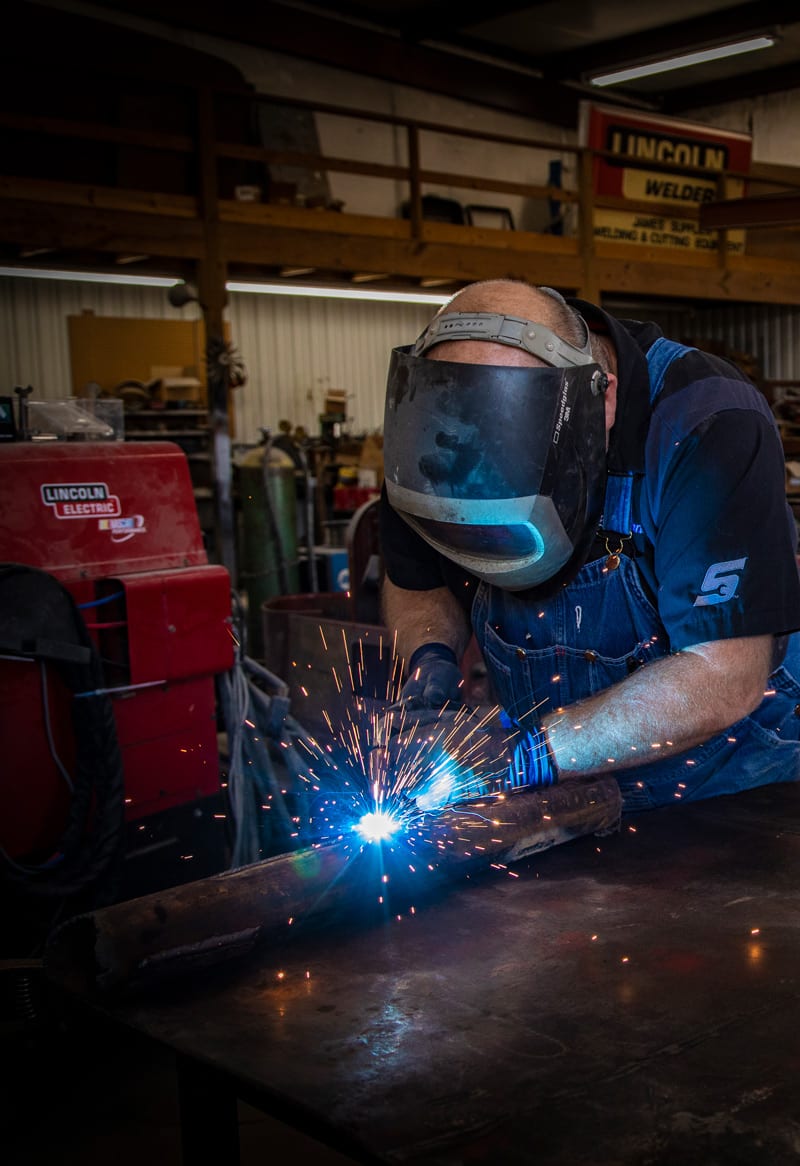Usual Welding Repair Issues and Exactly How to Address Them Efficiently
Welding repair work frequently encounter an array of concerns that can threaten the stability of the end product. Common troubles consist of poor penetration, porosity, and imbalance, among others. Each defect presents distinct challenges that call for specific methods for resolution. Understanding these issues is essential for welders aiming to boost their abilities and outcomes. This discussion will explore these usual welding fixing concerns and efficient techniques to address them.
Poor Penetration
Poor penetration occurs when the weld steel stops working to completely fuse with the base material, leading to weak joints and prospective structural failures. This issue typically comes from not enough warmth input, wrong electrode angle, or inappropriate welding speed. Welders may run into insufficient infiltration due to a miscalculation of the essential specifications for a certain material density or type. Additionally, contamination on the base product's surface area can hinder efficient bonding, intensifying the issue. To deal with insufficient penetration, welders ought to assure proper settings on their tools and keep a clean work surface. Normal assessment of welds is advised to determine any deficiencies early, permitting for timely modifications and the prevention of jeopardized architectural honesty in welded assemblies.
Porosity
Porosity is a common flaw in welded joints that manifests as small gas bubbles entraped within the weld steel. This problem can jeopardize the stability of the weld, resulting in decreased toughness and possible failure under anxiety. Montana Mobile Welding and Repair. Porosity commonly develops from contamination, dampness, or inappropriate welding methods, which permit gases to leave right into the molten weld pool. To attend to porosity, welders should guarantee appropriate surface area prep work, preserve a clean workplace, and use ideal welding parameters. In addition, choosing the best filler product and securing gas can reduce gas entrapment. Routine inspection and screening of welds can aid recognize porosity early, guaranteeing prompt restorative activities are taken, thus maintaining the high quality and integrity of the welded structure
Misalignment
Misalignment in welding can develop from numerous variables, consisting of improper setup and thermal expansion. Comprehending the origin is important for reliable resolution. Numerous correction strategies are available to straighten components and guarantee architectural stability.
Root causes of Imbalance
Welding misalignment usually comes from a variety of underlying concerns that can jeopardize structural stability. One main cause is improper fit-up of parts prior to welding, which can bring about voids and unequal surfaces. Variants in thermal development throughout the welding procedure can likewise lead to distortion, particularly if the products being signed up with have various coefficients of growth. In addition, inadequate securing and fixturing might stop working to hold elements safely in position, causing movement throughout welding. Improperly conserved tools, including welding machines and tools, might present inconsistencies in the weld grain, more adding to imbalance. Operator error, stemming from inadequate training or experience, can also play a significant function in producing misaligned welds.

Correction Strategies Available
Addressing imbalance properly calls for a mix of restorative techniques tailored to the certain problems available. One common method is using jigs or fixtures to hold parts in the proper position during welding, ensuring regular placement. Additionally, pre-heating the products can help in reducing distortion and improve fit-up. For significant misalignment, mechanical adjustment methods, such as utilizing hydraulic jacks or clamps, can be used to deal with the setting before welding. Post-weld heat treatment might also be needed to ease tensions triggered by imbalance. Lastly, cautious assessment and modification during the setup phase can protect against misalignment concerns from ending up being substantial problems, advertising a smoother welding procedure and enhancing total architectural integrity.
Distortion
Distortion is a typical difficulty in welding that can arise from different elements, including unequal heating and air conditioning. Recognizing the root causes of distortion is important for implementing efficient avoidance strategies. Resolving this concern not just improves architectural stability however likewise enhances the total top quality of the weld.
Sources of Distortion
When based on the extreme heat of welding, products typically undergo adjustments that can result in distortion. This phenomenon mainly develops from thermal expansion and contraction during the welding process. As the weld area warms up, the material broadens; upon cooling, it contracts, which can create internal stress and anxieties. In enhancement, unequal heating across a workpiece can exacerbate these anxieties, causing bending or flexing. The kind of product also plays a substantial duty; steels with varying thermal conductivity and coefficients of development may react in a different way, leading to unforeseeable distortions. Poor joint layout and insufficient fixturing can contribute to imbalance throughout welding, increasing the likelihood of distortion. Comprehending these causes is crucial for smaw welding effective welding repair service and avoidance approaches.
Prevention Techniques
Reliable avoidance strategies for distortion throughout welding emphasis on regulating warm input and guaranteeing proper joint design. Maintaining a constant warm input assists to reduce thermal development and tightening, which can bring about distortion. Making use of techniques such as pre-heating the work surface can also lower the temperature level slope, advertising consistent home heating. In addition, choosing ideal joint designs, such as T-joints or lap joints, can enhance security and lower stress and anxiety focus. Carrying out correct fixturing to protect the workpieces in area even more help in maintaining placement throughout the welding procedure. Ultimately, staggered welding series can disperse heat extra uniformly, avoiding local distortion. By using these approaches, welders can considerably lower the possibility of distortion and improve the general top quality of their welds.
Cracking
Fracturing is an usual issue run into in welding repairs, often resulting from different variables such as improper cooling rates, material option, or insufficient joint preparation. The event of cracks can greatly jeopardize the honesty of the weld, leading to potential failures throughout operation. To resolve this problem, welders should initially analyze the source, making certain that products are compatible and properly chosen for the certain application. In addition, controlling the air conditioning rate throughout the welding process is necessary; quick cooling can cause stress and lead to splitting. Appropriate joint design and prep work likewise add to reducing the danger. Carrying out these methods can boost weld quality and sturdiness, inevitably minimizing the possibility of cracking in ended up weldments.

Incomplete Combination
A considerable issue in welding fixings is insufficient fusion, which occurs when the weld steel does not effectively bond with the base material or previous weld passes - Montana Mobile Welding and Repair Belgrade Fabrication. This defect can bring about weaknesses in the joint, potentially compromising learn this here now the integrity of the bonded structure. Aspects adding to incomplete fusion consist of insufficient warm input, incorrect welding method, and contamination of the surface areas being joined. To resolve this concern successfully, welders should guarantee proper pre-weld cleaning and surface area preparation, along with readjust their welding criteria to accomplish ample penetration and blend. Routine evaluation throughout the welding procedure can also assist recognize insufficient blend early, enabling prompt rehabilitative actions to enhance the total top quality of the weld
Overheating
While welding fixings can enhance architectural integrity, overheating offers a substantial difficulty that can cause product deterioration. Extreme warm throughout welding can alter the mechanical homes of steels, causing decreased stamina, increased brittleness, and bending. This phenomenon is particularly vital in high-stress applications where structural integrity is extremely important. Recognizing getting too hot can involve aesthetic assessments for staining or distortion, in addition to keeping an eye on temperature level during the welding process. To reduce the dangers related to getting too hot, welders should employ suitable techniques, such as controlling warmth input, readjusting travel rate, and using appropriate filler materials. Additionally, executing pre- and post-weld heat treatments can assist restore product residential or commercial properties and improve the overall quality of the fixing, guaranteeing lasting efficiency and security.
Regularly Asked Concerns
What Are the Usual Signs of a Welding Issue?

Exactly How Can I Examine My Welds for Quality?
To evaluate welds for top quality, one can make use of aesthetic assessments, ultrasonic screening, and radiographic techniques. Each strategy assures architectural honesty, identifies problems, and confirms adherence to defined criteria, inevitably boosting the dependability of the bonded joints.
What Security Preventative Measures Should I Take While Welding?
When welding, one should prioritize safety and security by putting on appropriate individual protective equipment, guaranteeing proper ventilation, protecting flammable materials away, maintaining a tidy workspace, and recognizing environments to prevent crashes and injuries.
Can I Repair a Weld Without Remodeling the Entire Joint?
Fixing a weld without redesigning the entire joint is feasible, depending on the damage (Montana Mobile Welding and Repair Belgrade Fabrication). Methods such as grinding, adding filler material, or making use of a welding procedure can successfully deal with specific imperfections while maintaining the surrounding framework
What Tools Are Essential for Reliable Welding Repairs?
Crucial tools for efficient welding repair work include a welding equipment, wire brush, mill, protective gear, clamps, and filler products. Each tool plays a vital duty in ensuring top quality and security during the fixing process. Porosity commonly emerges from contamination, dampness, or improper welding techniques, which permit gases to escape into the molten weld swimming pool. Improperly conserved devices, including welding devices and devices, may introduce variances in the weld bead, you can try here more adding to imbalance. When subjected to the extreme heat of welding, materials commonly undertake modifications that can lead to distortion. Fracturing is a common concern experienced in welding repairs, typically resulting from various elements such as incorrect cooling prices, product choice, or insufficient joint preparation. A significant problem in welding fixings is insufficient fusion, which occurs when the weld steel does not effectively bond with the base product or previous weld passes.